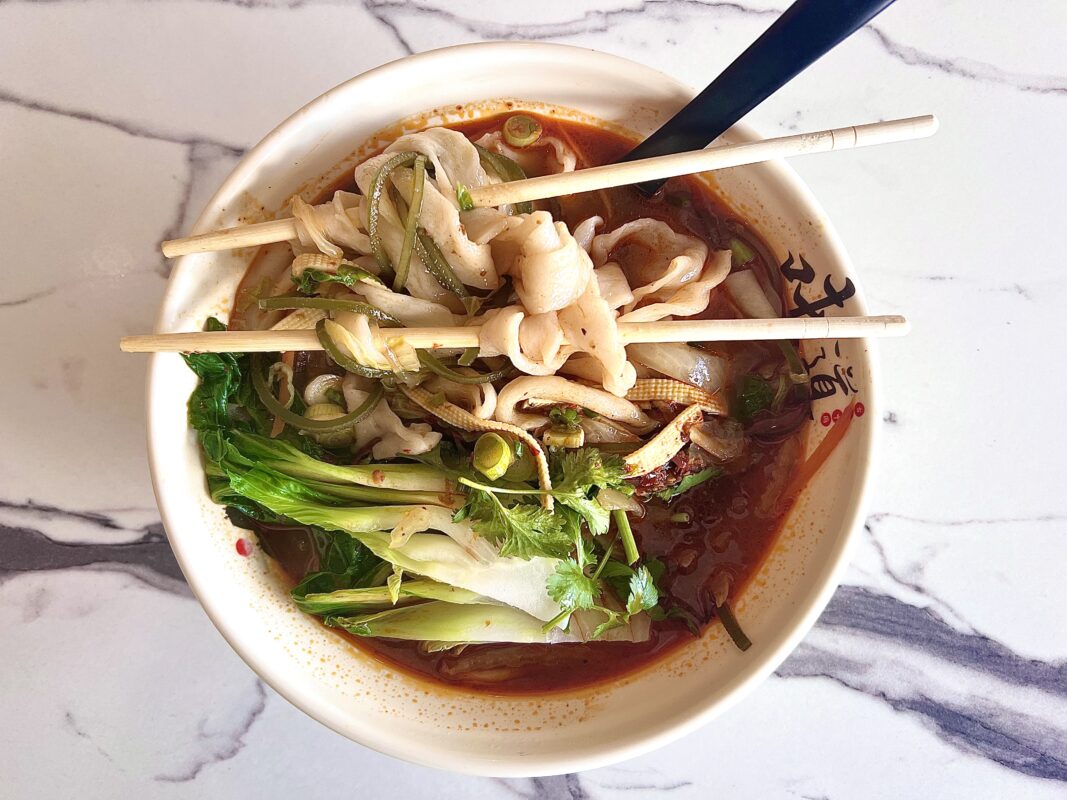
Yo Café is a tiny Chinese noodle joint tucked between a Dunkin donut shop and a nail salon in a York Road strip mall in Lutherville.
Opened two years ago by an owner from the Henan province of Central China, it’s a cozy, light-filled place decorated with pale green walls, bright red banners, window seating, a few tables, and a counter fronting a large back kitchen. It’s in that kitchen that the hand-pulled noodles, a Henan specialty, are stretched from pale wheat dough to thick, wide ribbons.
The noodles arrive in a lamb soup with threads of tofu skin and seaweed; a version of the same with beef; a soup with shredded pork and soybean sauce; and in a bowl with braised beef and either bok choy or radishes.
What distinguishes both Yo Café and its noodles is that they’re made to order. This means that large discs of dough are made each day, and then the noodles are pulled by hand—a process you can witness yourself if you peer through the curtains into the kitchen. This results in extraordinarily fresh, tender noodles that are both extremely delicious and fun to eat.
These are not spicy noodle dishes—Henan cuisine is not chile-saturated like Chengdu or Sichuan—but there are handy bowls of house-made chile sauce on every table, along with jars of soy sauce and black vinegar that add both acid and depth to more than just dumplings.
Or you can order the noodles in a spicy vegetable version, which comes out happily heat-charged, the vermillion-tinged broth enveloping a tangle of noodles, bok choy, cabbage, and fine threads of carrots, tofu skin, and seaweed. The spicy version wasn’t on the menu originally, but was added to appease chile-heads. And it is quite spicy, as one of the women helming the counter warned me. (She’s from Chengdu, and approved the recipe.)
Though the noodles are the main draw, there are other highlights, including Chinese burgers—also called murgers or roujiamo—a popular Shaanxi street food assembled from buns and cumin-spiced lamb, beef, or pork. Other regional specialties include the Big Plate Chicken with wide noodles, mapo tofu, pig ears in chile oil, crullers (which are terrific paired with soup), and an array of bao and dumplings. There are also occasional specials, like the zongzi—traditional bamboo-wrapped sticky-rice dumplings—offered during the springtime Duanwu Festival.
Flip the extensive, bilingual English/Mandarin menu over, and you’ll find a similarly sizable roster of boba drinks. They all come in three sizes, hot or cold, and with varying levels of sweetness—thankfully, as boba drinks can be wildly sugary.
There are drinks loaded with fresh fruit like mango, passion fruit, lychee, strawberry, and peaches. Other options include taro cream smoothies, mango slushes with milk foam, and mango-pomelo sago (pearls similar to boba but made from palm rather than tapioca). And there are those boba-loaded drinks—gorgeous concoctions that look disconcertingly like milk tea weighted with buckshot—which come in iterations like Earl Grey, oolong, genmaicha (a Japanese green tea made with roasted brown rice that should be more widely found than it is), buckwheat, and coconut milk.
Boba has become hugely popular, but it’s rare to find a menu with such range and flavor, and they operate well as dessert after a bowl of noodles or a plate of dumplings. (Or, for the more adventurous, lamb offal soup.) To make your drink even more dessert-y, add lychee jelly, red beans, milk foam, sago pearls, mango boba—or even get the brown sugar on top torched like crème brûlée—a pretty spectacular finish.
And yes, boba milk tea works splendidly to cool off after a particularly incendiary bowl of noodles.
